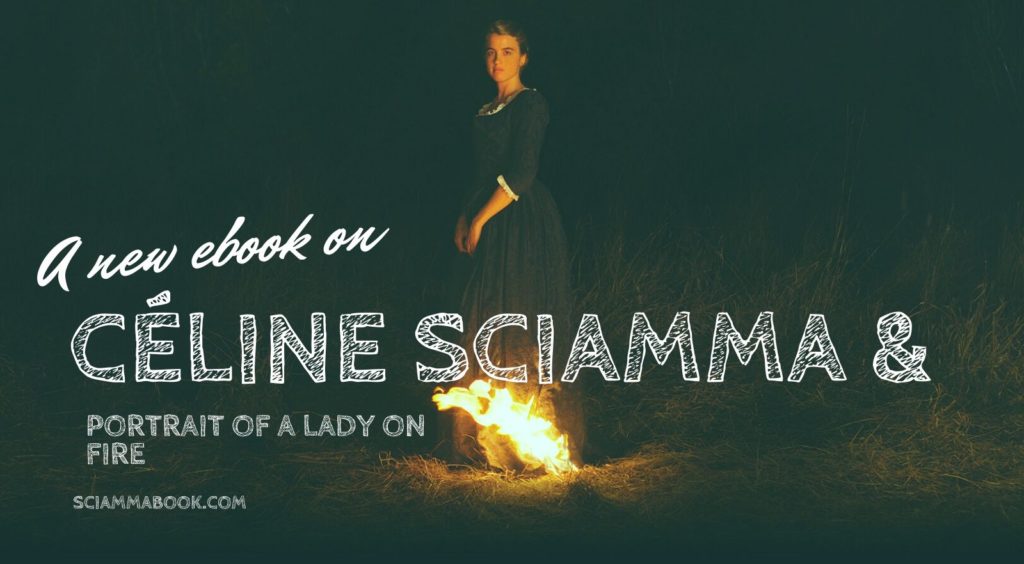From Water Lilies to Portrait of a Lady on Fire, we analyse 10 of Céline Sciamma’s best scenes, revealing what makes her a master. This is an excerpt from our ebook, Portraits of resistance.
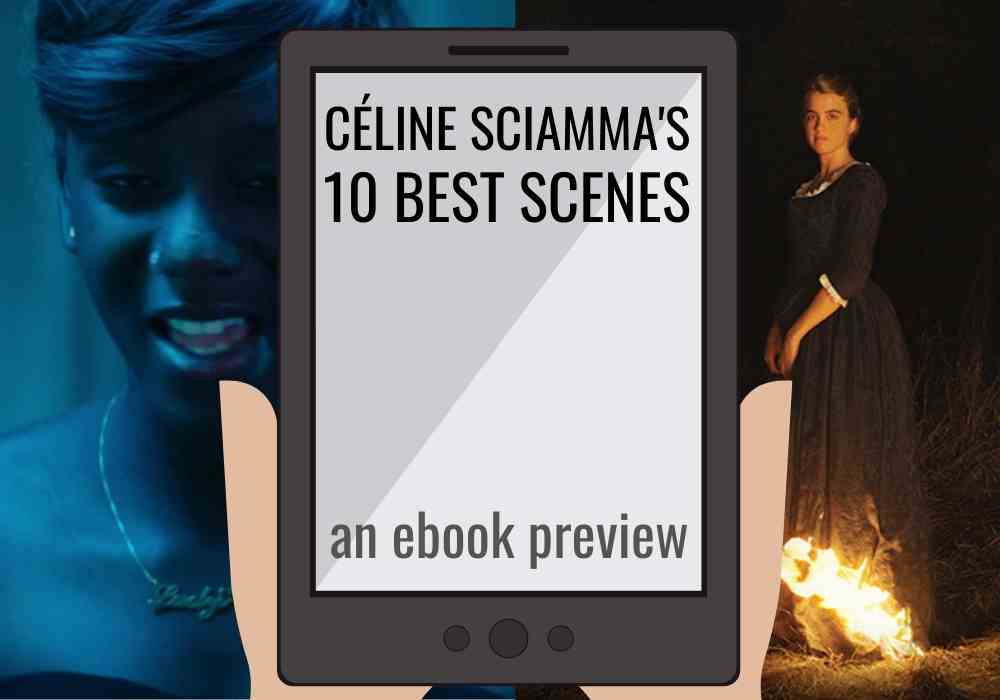
In order to give Seventh Row readers a glimpse into our latest ebook, Portraits of resistance: The cinema of Céline Sciamma, we’ve published this excerpt, which comprises Chapter Two of the book. You can buy your copy of the book here.
In this chapter, editors Alex Heeney and Orla Smith analyse ten of Sciamma’s best scenes, from Water Lilies (2007), Tomboy (2011), Girlhood (2015), and Portrait of a Lady on Fire (2019). Through these analyses, they get to the nitty gritty of what makes Sciamma a master, as well as providing a necessary refresher on Sciamma’s body of work before delving into these films in more detail later in the book.
We were inspired to publish these scene analyses by Lindsay Pugh’s review of Portraits of resistance, which she published on her excellent blog Woman in Revolt. Read an excerpt of her review here:
“One of the features that I most appreciated is an overview of Sciamma’s ten best scenes. Although it’s been years since I’ve watched a majority of her films, this breakdown helped me remember what I loved about each of them … Watching each scene and reading the analysis makes the experience similar to the New York Times “Anatomy of a Scene” feature. If you’re interested in exactly how Sciamma constructs her most memorable, magical moments, Smith and Heeney do a great job dissecting the craft.”
Marie watches the synchronised swimming, Water Lilies
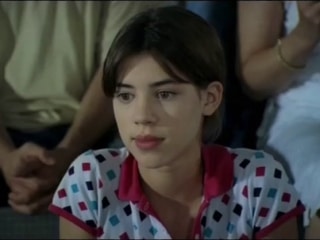
The opening scene of Water Lilies is reminiscent of the opening of Brian De Palma’s Carrie (1976): the camera tracks through a girls changing room while a horror-esque synth score plays. Carrie is a horror film about a girl who doesn’t fit in with perceived standards of normalcy. While not a genre film, Water Lilies is also about the sometimes horrific business of being a girl expected to conform to the strict rules of femininity. Horror cinema is evoked in the ominous music that scores this opening, which highlights how what should be a space safe from the male gaze — a changing room where no boys are allowed — is actually sinister and full of judgement. This is the world of the synchronised swimming team headed by Floriane (Adèle Haenel). But we meet ur protagonist, Marie (Pauline Acquart), not in the changing room, but walking by the side of the pool and up into the stalls, where she watches the team perform; she is on the outside looking in..
The team’s performance dazzles us (and Marie) with a spectacle of perfect femininity; the teen girls involved spend the rest of the film getting hurt trying to live up to that ideal. Marie watches hungrily from her seat as the team of beautiful, athletic teen girls perform a synchronised swimming routine. We’re very much in Marie’s perspective: she’s shot in closeup while the girls in the pool are framed together and from afar. Marie falls for the performance, particularly the performance of the gorgeous Floriane.
Synchronised swimming is the perfect metaphor for the way the girls perform femininity throughout the film. Above water, they smile brightly, showing their sparkling white teeth off to the crowd. They’re not wearing goggles, because the sport favours the girls’ unencumbered beauty more than it does their wellbeing. They are expected to look perfect and their dance is supposed to seem effortless, but under the water, where the onlookers can’t see, their legs are working overtime to keep them afloat and balanced. – Orla Smith
Dancing at the club , Water Lilies
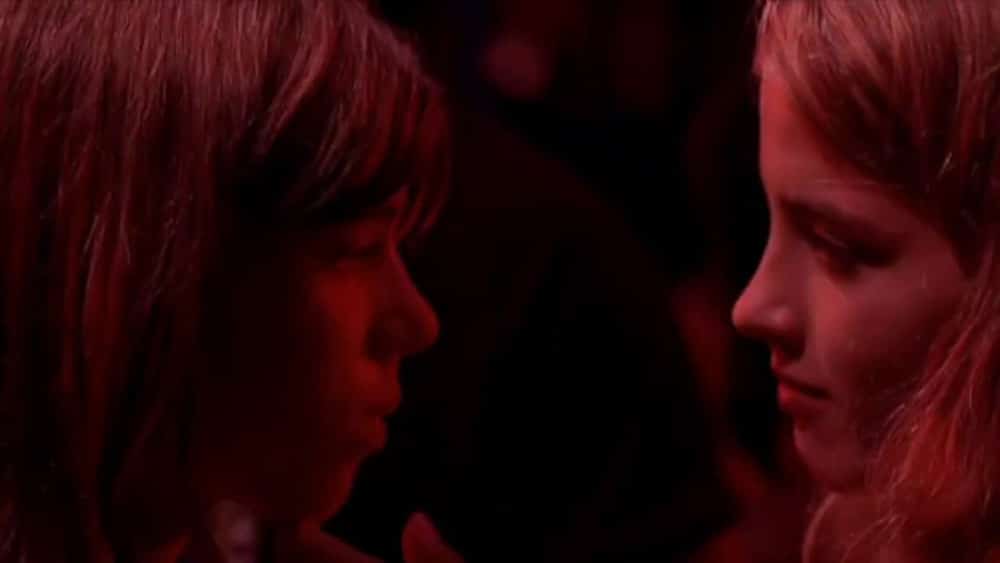
Although Marie spends most of Water Lilies infatuated with Floriane, Floriane is always caught between her own desire for and tenderness toward Marie and her conviction to become an object of desire for the male gaze. Repeatedly, Floriane flirts with Marie, only to pull back in favour of a male partner; sometimes, it feels like simply a cruel tease, but Haenel always shows us Floriane’s internal conflict about their relationship.
This tightrope of teasing flirtation and withdrawal is no better demonstrated than when Marie and Floriane visit a club in search of a man to deflower Floriane. When they first arrive, we watch Floriane in closeup, with Marie out of focus in the background. Floriane’s’s eyes dart back and forth in uncertainty and insecurity before she whips her head around to look at Marie, almost desperate with the desire to connect with her. Marie is sipping on a drink at the bar, her head supported by her hands in fatigue, frustration, and boredom. We clock their eyes meeting from the smile of encouragement Marie gives Floriane, who turns back to the camera with a slight grin, only to bite her lip in uncertainty. We then cut to Marie in wait, twirling on her bar stool, before Floriane looks back again and makes her move. The camera barely moves as Floriane crosses to Marie, holding out her hand in invitation.
As they head to the dance floor hand in hand, the music speeds up and gets more charged. Floriane is slyly smiling, but is it because she’s happy to be with Marie or because Marie is a good vessel for her own exhibitionism? As they dance, she flirts with Marie, touching her face and hair, and in closeup, pushing her face up to Marie’s, but it feels like Floriane is following a seduction playbook. Only for a few seconds do we see her show real tenderness toward Marie, looking at her with devotion, leaning in as if to kiss her, only to back up when Sciamma cuts to a wide shot of Floriane dancing with a random man, separated by several feet from Marie. It’s a dance Floriane will continue to do throughout the film: come in close, emotionally and physically, to tease Marie, only to withdraw toward what’s expected. – Alex Heeney
A family dinner, Tomboy
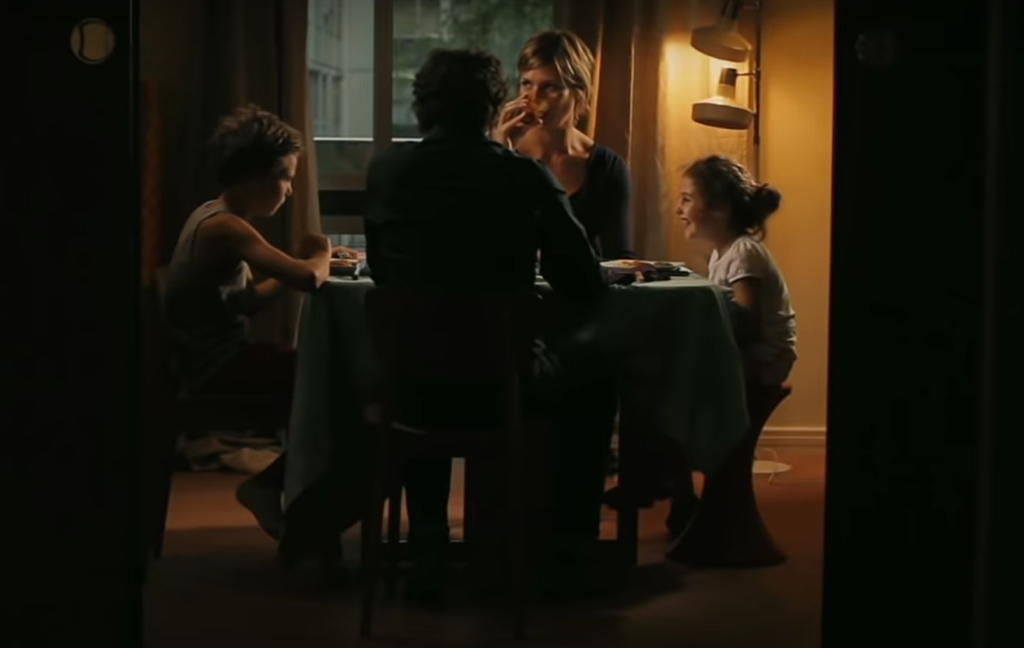
The heart and the humour in Tomboy comes from Laure’s (Zoé Héran) relationship with their little sister, Jeanne (Malonn Lévana). Laure finds true acceptance with Jeanne, who embraces their boy persona, Mickäel, without batting an eye. With Jeanne, Laure is free to mess about and be as masculine as they like without being judged, such as when Jeanne cuts Laure’s hair and the two fashion moustaches out of the clippings. Jeanne is the only family member Laure is willing to let in on the secret of their boy persona; she becomes a confidant when Laure brings her along to hang out with Laure’s friends.
The ultimate test of Jeanne’s trustworthiness is when the family sits down for dinner just after Laure has revealed their Mickäel persona to Jeanne. Jeanne may be accepting, but will she be able to keep her mouth shut to their parents? Laure begs her to keep the secret, promising that if she does, Jeanne can hang out with Laure’s friends more. But that’s no guarantee that the very young Jeanne won’t slip up. It starts off as a tense scene, with Jeanne staying silent at the table but smiling knowingly: it’s clear that she’s sitting on a secret, and the parents start to get suspicious.
But that tension is relieved in a moment of sweetness. After her parents probe Jeanne to tell them more about her day hanging out with Laure’s friends, her devious smile grows and grows until she can’t hold back words anymore. But she doesn’t out Laure. Instead, Jeanne delights in the secret that she and her older sister share: “My favourite one is Mickäel,” Jeanne grins, pretending that Mickäel is a friend of Laure’s that she met that day. She shoots Laure a mischievous look, and Laure’s relief melts into a look of love and gratitude for their sister. It’s the beaming smile of someone who feels totally accepted for who they are by a loved one. – OS
The rugby game, Girlhood
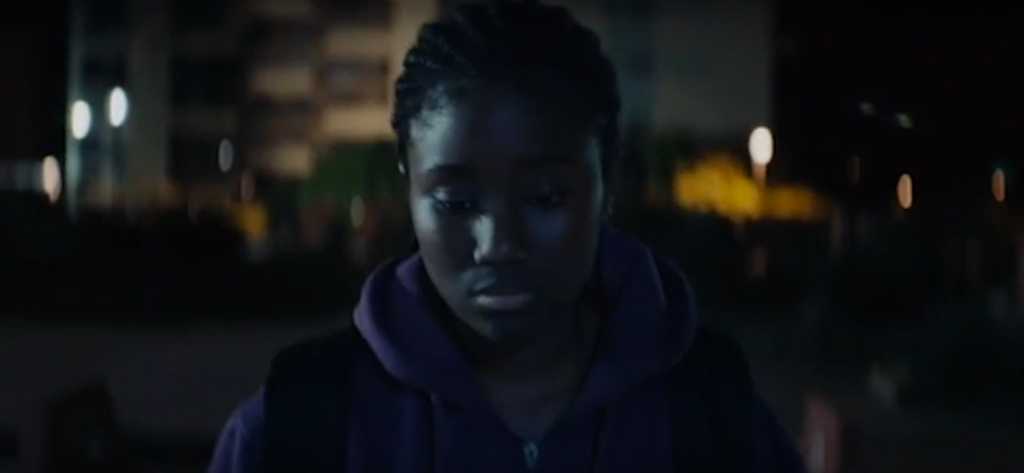
Girlhood begins with a rugby game: a flurry of bodies run amongst and collide with each other. Their practiced moves help them move as one, so they’re unmistakably a team. Even at the end of the game, when all is said and done, friendly pats on the back, smiles, and laughs indicate harmony. But there’s also no room for individual identities here. Each player wears a bulky helmet so you can’t see their faces, and the only differentiation between their outfits is the colour of their shirts that indicate which side they’re on, and the writing on the back of those shirts. Our protagonist, Marieme (Karidja Touré), is among them, and her place in this rowdy game, fighting for the ball in a scrum, establishes her as the resilient fighter we’ll come to know and love. But she’s virtually unidentifiable amongst her team; it’s several minutes into the film before we actually see her face.
The belonging that the team offers Marieme is synthetic and doesn’t last past the pitch. We later see the group walking home from the match, talking and moving in unison. We can see their faces now, but it’s still near impossible to extrapolate one voice from the overall loud thrum of conversation. Marieme is at the back of the crowd, walking out of step with the rest. We don’t see her until enough of the team has left to reveal her face behind them. Too wrapped up in their own conversations, her peers don’t seem to clock her loneliness, or they make the effort to help her fit in. From the outset, Sciamma has established Marieme as a loner — head down, hands in pockets, keeping to herself — who desperately wants to be part of a group, but hasn’t yet found one that embraces her. – OS
Dancing on the train, Girlhood
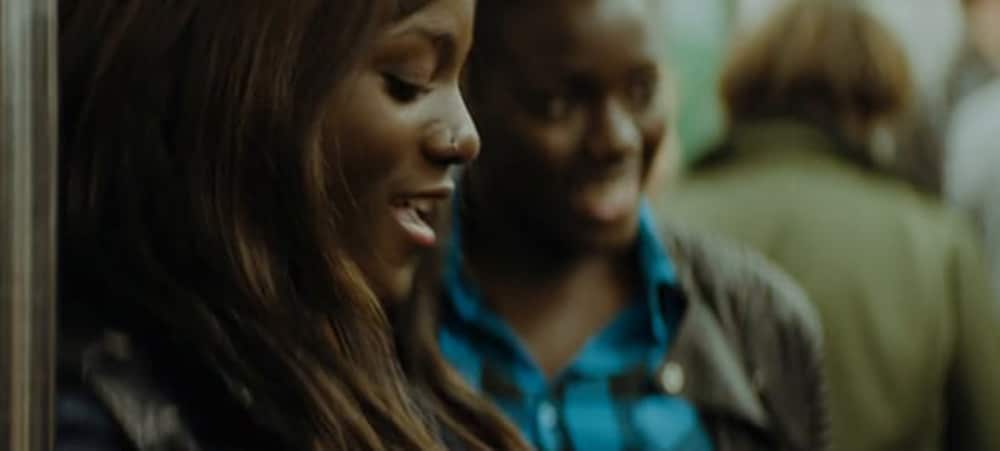
The first time Marieme comes out of her shell is on the subway in Paris with the ‘bande de filles’ of the film’s French title: it’s the first time she’s hung out with them, and as Fily (Mariétou Touré) observes, “She’s having a blast!” They’ve just bonded over heckling another girl gang in the metro station, and Marieme is sheepishly but uncontrollably smiling.
Lady starts playing music on her smartphone and dancing, telling Marieme to follow her lead and choreography. Sciamma’s camera moves back and forth between the girls, without letting both hold the frame together. Lady is dancing with abandon, and Marieme slowly gets more and more into it. Their friends cheer them on, chanting “L-A-D” and moving to the music and smiling. When we cut back to Marieme, she’s alone in the frame, close to the pole, moving slowly and tentatively, eyes down. But as her new friends observe, “She’s into it.” They encourage her: “Give it all of you’ve got, Marieme.”
Sciamma cuts between the three girls Marieme has just befriended, confidently dancing and moving to the music, and Marieme, gaining confidence by the second to move more decisively and raise her eyes. But the camera spends more time with the three girls than Marieme, who is not yet fully part of the group, although we sense she is being inducted into it with this impromptu dance on the subway. Marieme slowly opens up her body to take up more space, beaming at her new friends.
This is the first of three dance sequences in the film which chart Marieme’s relationship to the ‘bande de filles’ and her own burgeoning self-confidence. Her movements here are gaining confidence, but still tentative. The girls’ voices ever enter the frame with her; their bodies are always in separate frames. – AH
Shine bright like a diamond, Girlhood
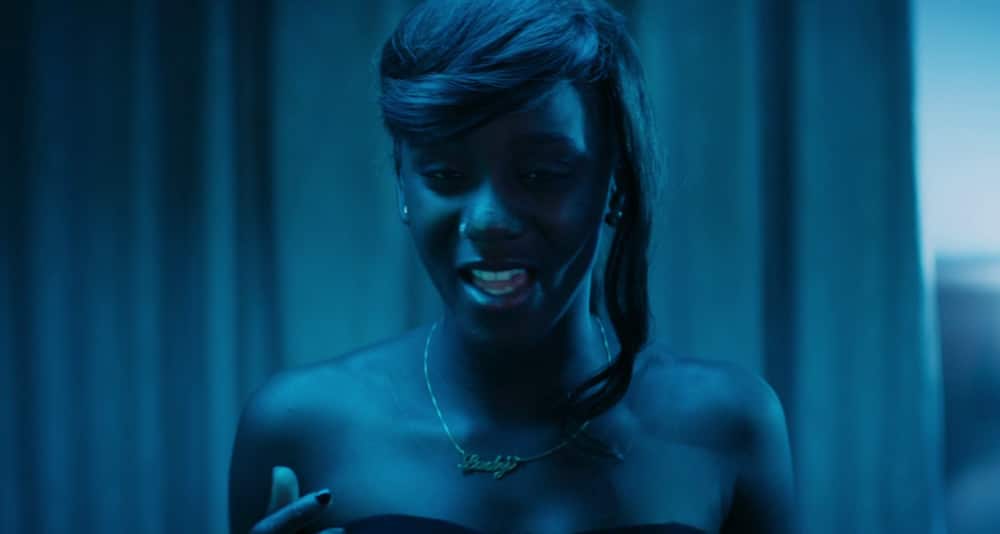
When I interviewed Céline Sciamma about Girlhood in 2015, she told me that this scene, “The Rihanna scene, is the key scene, for me. It was written for the song. It was the scene I most wanted to shoot. I was obsessed with the scene. Not because it’s a clip, but because it’s really a narrative piece. It’s about the birth of a friendship — how a friendship actually rises.” All of Sciamma’s films include fantastic scenes which track a shift in a relationship through dance and movement; the scene set to Rihanna’s “Diamonds” in Girlhood, in which Marieme makes the transition from someone slightly on the outside of the ‘bande de filles’ to a fully integrated part of the group, is perhaps Sciamma’s best and most iconic. Set in a hotel room that the ‘bande de filles’ have rented for the night, the girls dress up in stolen, glamorous dresses, get high, and lip sync to Rihanna’s “Diamonds”.
The sequence opens on a closeup of Lady (Assa Sylia), looking direct into lens, bathed in blue light that makes her skin sparke, lip syncing “Shine bright like a diamond,” as the camera slowly pulls back. As she mouths, “You and I are like diamonds in the sky,” the camera pans right to invite Adiatou (Lindsay Karamoh) into the frame. They hold hands and dance together and twirl, giant smiles on their faces. Eventually, Fily (Mariétou Touré) joins in, and Sciamma cuts to a reverse shot of Marieme sitting on the bed, smiling with joy at the girls’ joy, dancing together as one. As the camera pushes in on Marieme, we watch her as she gains the confidence to stand up and join them. When she enters the frame with the other three girls, at the centre of it, she’s lip syncing and dancing with abandon, with a freedom and confidence we’ve never seen before. As Marieme lip syncs, “We’re beautiful like diamonds in the sky,” it feels like she believes this about herself for the first time in the film, and her joy is infectious. By the end of the scene, the girls are singing, not just lip syncing, eyes closed at times, and finally, hugging. – AH
“We’re in exactly the same place,” Portrait of a Lady on Fire
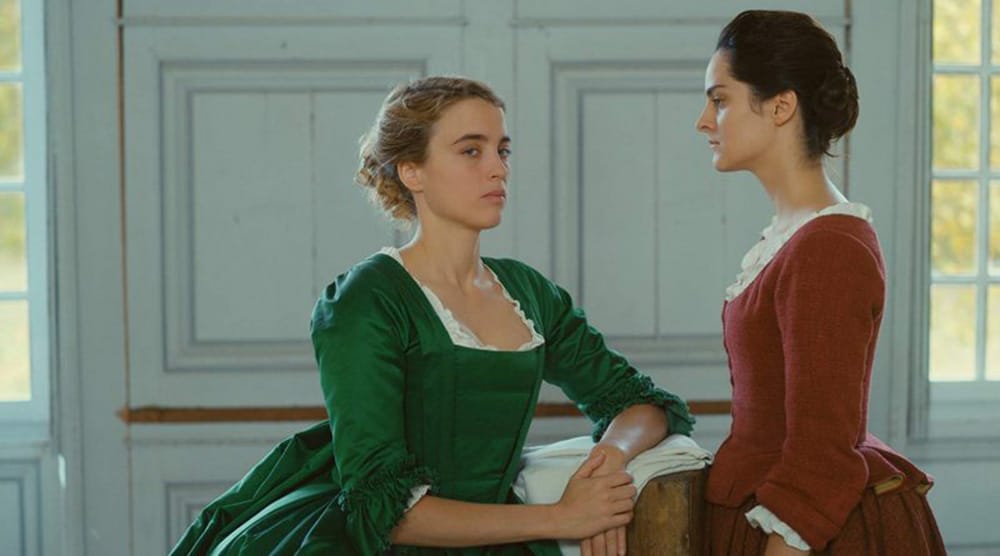
“I can’t make you smile,” Marianne (Noémie Merlant) worries, staring at her portrait of Héloïse (Adèle Haenel), then looking up as if in question to the woman herself. In a reverse shot, Héloïse poses and answers, “Anger always comes to the fore.” While they are in the position of painter and muse, they do not fit the traditional mould where the artist has full control over the image of their muse, shaping and bending them to fit the desired image. Here, Marianne finds her subject too powerful to bend: she cannot make Héloïse smile if it is not in her nature.
This scene, where Héloïse finally agrees to pose for her wedding portrait, is where the boundaries between artist and muse are fully broken down. Marianne tries to assert her authority as the observer when she relays the observations she’s made about Héloïse while painting her: “When you’re moved, you do this with your hand. When you’re embarrassed, you bite your lip. When you’re annoyed, you don’t blink.” With each observation, we watch Héloïse, sometimes unconsciously, making the very movements that Marianne describes. “Forgive me, I’d hate to be in your place,” Marianne asserts, speaking both of being the scrutinised subject, and being a woman sold into marriage against her will. But we also occasionally cut to her in a similar reverse shot from Héloïse’s perspective, hinting that Héloïse is watching Marianne just as Marianne is watching her.
Confronted by Marianne’s pity, Héloïse indignantly reveals, “We’re in the same place. Exactly the same place.” By firmly ordering Marianne to “Come here,” Héloïse transforms a traditional shot reverse shot into a two shot, where the two women share the frame. She disrupts the artist and muse dynamic by insisting that they are both equally on display. “When you don’t know what to say, you touch your forehead,” Héloïse tells Marianne, and again, Héloïse’s words are confirmed as we observe Marianne do just that. “When you lose control, you raise your eyebrows. And when you’re troubled, you breathe through your mouth.” Héloïse has been watching, too. While painter Marianne struggles with where to look, her eyes flitting about and only hesitantly resting on her subject, Héloïse looks intently at Marianne, her gaze confident and unfaltering. – OS
A fireside song, Portrait of a Lady on Fire
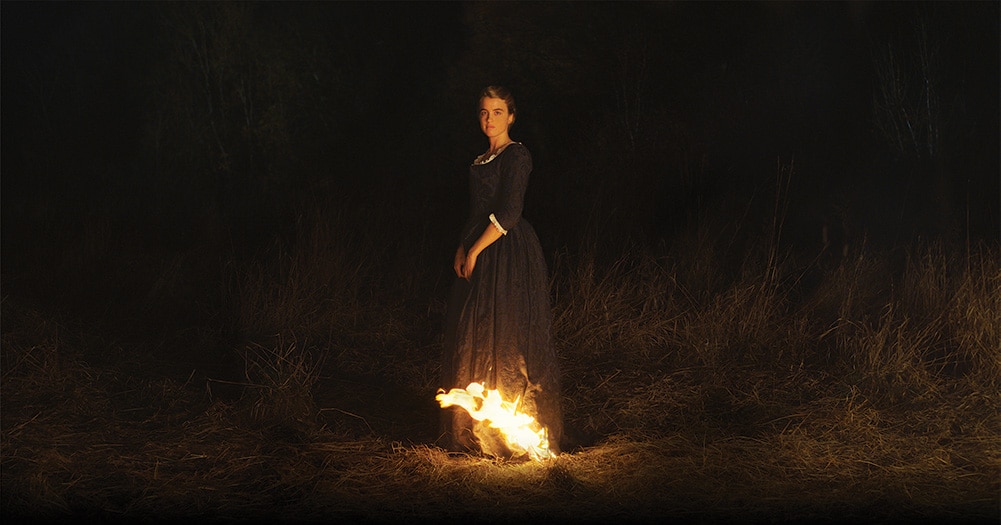
One night, Héloïse’s maid Sophie (Luàna Bajrami), Héloïse, and Marianne walk cloaked in silhouette at sunset, and arrive at a meeting of women in the dark of night, their faces illuminated only by a bonfire. It’s a gathering of women, and the first sense that there’s a larger community of women helping women outside of their little threesome. It is here that Sophie gets advice about how to abort her foetus, and the three central women of the film are surrounded by the voices of other women, first humming a crescendo, as they gather around the fire, before breaking into song. Like in “Diamonds,” Sciamma cuts between the gathered group of women and Marianne, the biggest outsider since she does not live in Brittany, who observes the magic that happens when women gather. Fire has figured throughout the film, giving warmth to a room in the manor, and also making us aware of the room’s emptiness and loneliness. But only outside, in nature, among other women, do we truly feel its power to reveal and to hide — the women glow, but almost in secret, away from the world of men.
The gathered women of all ages, young and old, start singing and clapping, and Sciamma pans right to reveal each woman joining in with song, each clapping a rhythm in syncopation with the others. In this group together, these women are confident and powerful, singing with strength, smiling at their community. The song, “Portrait de la jeune fille en feu,” was written for the film, and just like “Diamonds,” the scene was designed around and choreographed for this piece. Sciamma listened to the piece throughout the making of the film, and its rhythms — the way the women’s clapping complements each other — can be felt in the way Sciamma focuses on the sounds of footsteps and breathing throughout the film, all choreographed, creating a kind of musical collaboration between Héloïse and Marianne.
Marianne, in profile, is mesmerized, and catches Héloïse’s eye, whom we then see in reverse shot, also in profile, on the other side of the fire. She’s beaming back at Marianne, in response to the community they’ve temporarily gained access to and also Marianne’s gaze. Sciamma cuts back and forth between shot and reverse shot. Sparks start to fly in Héloïse’s frame and the edge of her dress catches fire. It’s a remarkable image, and one that Marianne will put to paint later. It shows Héloïse at the height of her power and agency, inviting Marianne’s gaze and returning it, surrounded by a community of supportive women, a temporary reprieve from patriarchal forces. That Héloïse catches fire suggests both that she has the power to attract the flame and is vulnerable to its damaging effects. Here, among women though, the flame on her dress is doused before it can become a real threat. – AH
The abortion, Portrait of a Lady on Fire
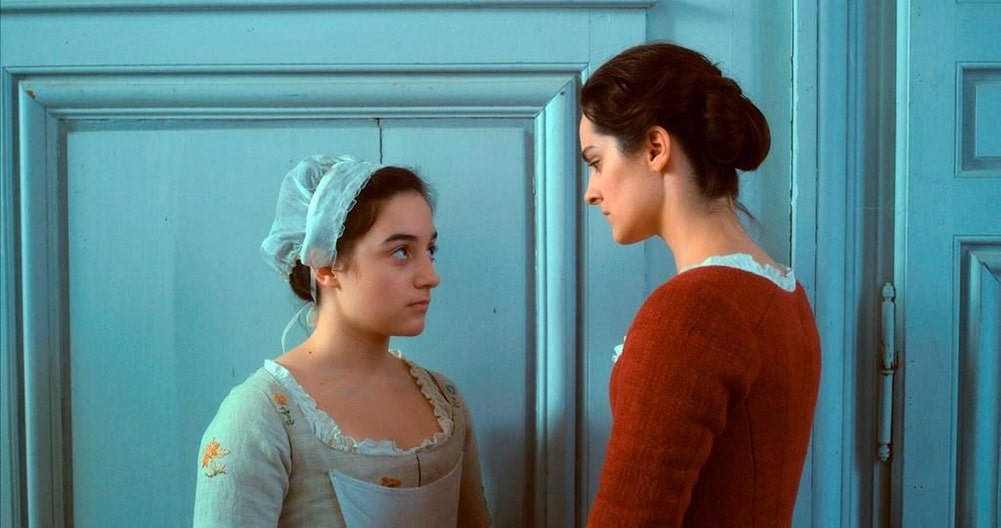
Though a work of fiction written in the 21st century, Sciamma’s Portrait of a Lady on Fire is committed to telling women’s stories that have gone untold in history: the story of female painters, of female desire, and of the sacrifices women had to make in a time governed by patriarchy. Within this framework, Sciamma includes a subplot about Sophie’s unwanted pregnancy, and the lengths she goes to in order to abort it. When her home methods taught by Marianne don’t work — running tirelessly back and forth on the beach, falling from a height — she seeks the help of an elder at the bonfire.
In addition to showing us the failed and laboured attempts at abortion, Sciamma also asks us to bear witness to the real thing; in turn, Héloïse forces Marianne to do likewise. We watch them wait nervously at the door of the abortionist in daylight, only to enter a dark room illuminated only by the fire. Here, many generations collide. A young girl helps Sophie undress. A woman old enough to be her mother prepares a tincture, and a woman old enough to be her grandmother performs the procedure. Marianne and Héloïse stand back in a two-shot, watching the preparations. On the bed where the procedure will take place, a baby is crying, and her young sister comforts her. Sciamma holds on the procedure and then the reverse shot of Marianne and Héloïse watching. Marianne tries to turn away, but Héloïse implores her to bear witness, thereby imploring us, the audience, to bear witness to the lengths women have gone to, throughout history, to fit into a patriarchal world. Sophie writhes in pain, as a baby at her side holds her hand and touches her nose, and finally, Sophie cries.
That evening, as Sophie rests, Héloïse decides that it’s not enough for only her and Marianne to have bared witness: she wants to memorialize the event as an artwork. Earlier in the film, Marianne has explained what constitutes suitable subject matter for art — the nude female, the nude male — and how they are depicted. Women aren’t allowed to have male models, and thus are kept out of the club of geniuses, for nude men are the subject of many masterpieces. Abortions are something that happen regularly but nobody discusses, so we understand that it is an act of defiance and resistance for Marianne to commit this event to paint. In Marianne’s makeshift bedroom, Sophie lies in position on the floor, her knees up and bent, and Héloïse sits in the place of the abortionist. Mariannes observes and paints, making this invisible female experience visible, even if it’s not art that can ever be shown in a gallery, and thus, committed to the history books. – AH
Héloïse listens to Vivaldi, Portrait of a Lady on Fire
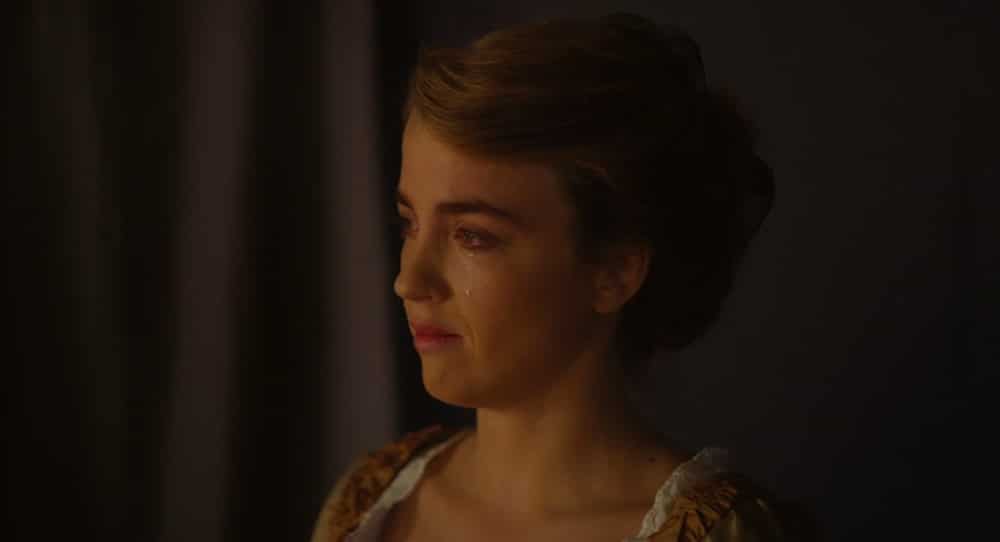
Who could forget the exhilarating final shot of Portrait of a Lady on Fire? Years after their love affair, Marianne sees Héloïse for the last time, at a concert. Marianne watches as Héloïse sits in a box alone, her eyes fixed intently on the orchestra as they play Vivaldi’s The Four Seasons. It’s a melody that evokes strong memories of their time together: Marianne played this very piece to Héloïse as they were falling in love, using the piece to demonstrate the power of music to Héloïse, who had never heard an orchestra at the time. Over the course of several minutes, Sciamma’s camera slowly pushes in on Haenel’s face as she cries, mourns, and smiles over the memory of her lost love evoked by the music.
The obvious comparison is Timothée Chalamet’s final scene in Call Me by Your Name, where the memory of his past lover replays on his face just as it does here on Héloïse’s. But in Portrait of a Lady on Fire, the gaze itself is crucial — not just of Héloïse but of Marianne, who is watching her. In Call Me by Your Name, we aren’t looking at Chalamet through anybody’s eyes; but here, we’re looking at Héloïse through Marianne’s eyes. “She didn’t see me,” Marianne utters breathlessly in voiceover, speaking the film’s final lines.
The myth of Orpheus and Eurydice is threaded throughout the film in Sciamma’s screenplay, first introduced when Héloïse, Marianne, and housemaid Sophie discuss it around a candlelit dinner table. In the myth, Orpheus looks back at his lover one last time, even though he knows that looking at her means she will die rather than simply be separated from him forever. This tension of the gaze — its irresistible nature and its transience — is felt throughout Portrait. So often it is Héloïse commanding Marianne to look, whether that be daring to witness Sophie’s abortion, or telling Marianne to look back at her one last time before they part. The whole final shot of Haenel’s face is wrought with the tension of an onlooker hoping desperately that Héloïse will turn and look back. But now, years after the two were separated, they have already spent their final mutual looks, and will never be granted one again. Rather than looking back at Marianne, like Orpheus, Héloïse must live with the memory of her evoked by Vivaldi’s music. – OS
